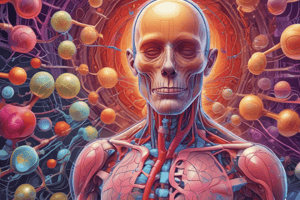Podcast
Questions and Answers
What is the primary function of the kidneys?
What is the primary function of the kidneys?
Regulate the volume and composition of the extracellular fluid.
What is the functional unit of the kidney?
What is the functional unit of the kidney?
- Glomerulus
- Bowman's capsule
- Nephron (correct)
- Collecting duct
The kidneys only eliminate foreign compounds and do not play a role in homeostasis.
The kidneys only eliminate foreign compounds and do not play a role in homeostasis.
False (B)
Which of the following substances are primarily involved in maintaining acid-base balance in the body?
Which of the following substances are primarily involved in maintaining acid-base balance in the body?
The ____ is responsible for collecting glomerular filtrate.
The ____ is responsible for collecting glomerular filtrate.
What is the normal volume of tubular filtrate formed per day?
What is the normal volume of tubular filtrate formed per day?
The kidneys maintain plasma/ECF osmolarity constant at around 283 mosmol/l.
The kidneys maintain plasma/ECF osmolarity constant at around 283 mosmol/l.
Urine is comprised of H2O, urea, creatinine, ions, and ____.
Urine is comprised of H2O, urea, creatinine, ions, and ____.
Which process is NOT performed by the nephron?
Which process is NOT performed by the nephron?
What percentage of filtered water is reabsorbed by the nephron?
What percentage of filtered water is reabsorbed by the nephron?
Which part of the nephron establishes an osmotic gradient?
Which part of the nephron establishes an osmotic gradient?
Flashcards are hidden until you start studying
Study Notes
Introduction to the Kidney
- The kidney is a key organ in homeostasis, responsible for maintaining the volume and composition of extracellular fluid (ECF).
- Kidneys regulate the volume and composition of plasma, which in turn regulates the volume and composition of ECF.
Kidney Structure
- Kidneys are bilateral retroperitoneal organs, located on either side of the spine under the ribcage.
- Each kidney has a renal artery and vein as its blood supply.
- Filtrate forms in Bowman's capsule in the cortex of the kidney.
- Urine flows from collecting ducts into calyces.
Functions of the Kidneys
- Regulate the volume and composition of ECF:
- Regulate plasma volume and composition.
- Maintain blood pressure.
- Maintain osmolarity (solute concentration) of body fluids.
- Eliminate potentially toxic metabolic wastes and foreign compounds.
- Regulate the quantity and concentration of extracellular fluid ions (Na+, K+, Cl-, Ca2+, PO43-).
- Maintain acid-base balance (pH).
- Excrete waste products of metabolism (urea, uric acid).
- Excrete foreign compounds (drugs, food additives).
- Convert vitamin D to its active form (by proximal tubule cells).
- Produce erythropoietin (by cells in the interstitium of the cortex/outer medulla).
Body Fluid Composition
- Water accounts for 60% of body mass (2/3 intracellular, 1/3 extracellular).
- Extracellular fluid is the fluid outside cells, consisting of plasma and interstitial fluid.
- There is free exchange of water and solutes (except proteins) between plasma and interstitial fluid across capillary walls.
- Distribution of fluid depends on hydrostatic and osmotic forces.
Determinants of Plasma and ECF Osmolarity
- Plasma osmolarity is determined mainly by NaCl content relative to water content.
- A decrease in water content increases NaCl concentration, increasing osmolarity.
- An increase in water content lowers NaCl concentration, lowering osmolarity.
- Kidneys maintain water balance to maintain plasma/ECF osmolarity constant.
The Nephron
- The nephron is the functional unit of the kidney, with approximately 1-1.2 million nephrons in each kidney.
- Each nephron consists of two parts: the renal corpuscle (glomerulus and Bowman's capsule) and the tubular system.
- The tubular system includes the proximal convoluted tubule, loop of Henle, distal convoluted tubule, and collecting duct.
Simple Overview of Urine Formation
- Filtration of blood to form tubular filtrate (mainly salt and water).
- Reabsorption of most of the filtrate back into the blood, adjusting salt and water content to match intake.
- Secretion from blood into filtrate of certain substances.
- Final urine formation occurs in the collecting duct.
Renal Blood Flow and Blood Supply to Nephron
- Renal blood flow (RBF) is approximately 1.2 L/min, with a high blood supply to the kidneys (1/5 of cardiac output).
- Blood supply to the nephron comes from the renal artery, which subdivides into many afferent arterioles.
- Glomerular capillaries recombine to leave Bowman's capsule as efferent arterioles, which give rise to peritubular capillaries investing the tubular system.
Studying That Suits You
Use AI to generate personalized quizzes and flashcards to suit your learning preferences.




